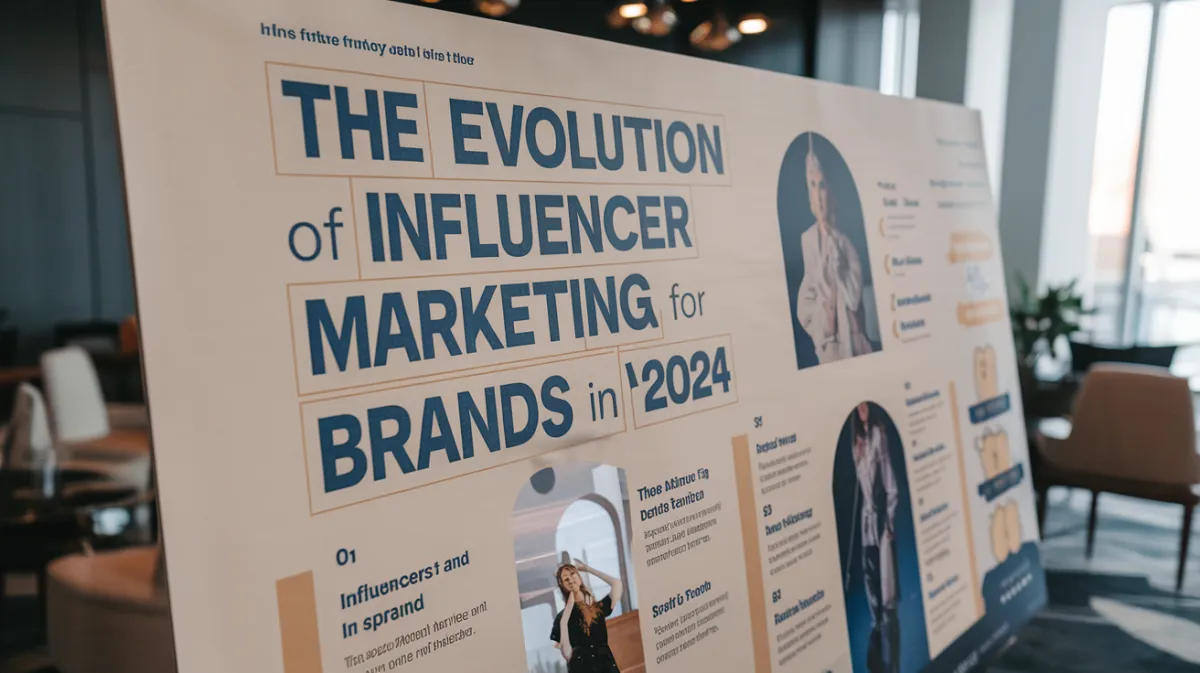The Evolution of Influencer Marketing: Insights for Brands in 2024

Influencer marketing has changed a lot since it first began. In the past, only big celebrities promoted products. Now, many different types of people can be influencers. Brands have shifted from using just famous people to working with smaller, more focused influencers who connect with specific groups of people.

This change has made influencer marketing more effective. Brands can now reach exactly the right people who might want to buy their products. They work with influencers who have loyal followers in certain areas like fashion, tech, or fitness. This helps brands talk to people who are already interested in what they sell.
Social media has played a big role in how influencer marketing has grown. Platforms like Instagram, YouTube, and TikTok have made it easier for influencers to share content and for brands to track how well their campaigns work. As social media keeps changing, influencer marketing will likely keep evolving too.
Key Takeaways
- Influencer marketing now includes a wider range of people, not just celebrities.
- Social media platforms have shaped how influencers create and share content.
- Brands can now reach more specific groups of people through targeted influencer partnerships.
The Evolution of Influencer Marketing
Influencer marketing has transformed dramatically since its inception. It has shifted from celebrity endorsements to leveraging everyday social media users with engaged followings.
The Rise of Social Media Platforms
Social media platforms sparked the influencer marketing revolution. Instagram launched in 2010, giving users a visual way to share their lives. It quickly became a hub for influencers to showcase products.
YouTube allowed creators to make longer video content. Many built large audiences through tutorials, reviews, and vlogs. Brands took notice and started partnering with these creators.
TikTok exploded in popularity, especially with younger users. Its short-form video format created new opportunities for influencers to promote products creatively.
From Celebrity Endorsements to Micro-Influencers
Traditional celebrity endorsements dominated early influencer marketing. Brands paid famous actors and athletes to promote their products.
As social media grew, a new type of influencer emerged. These were everyday people who built followings around specific interests.
Micro-influencers, with smaller but highly engaged audiences, became valuable to brands. They often had more authentic connections with their followers. This led to higher trust and engagement rates for sponsored content.
The Expansion into Various Content Formats
Influencer marketing began with simple product photos on Instagram. It has since expanded to many content types.
Video became crucial, with YouTubers creating in-depth product reviews. TikTok's short clips allowed for quick, entertaining promotional content.
Live streaming on platforms like Instagram and YouTube let influencers interact directly with audiences. This created more engaging sponsorship opportunities.
Podcasts opened up audio sponsorships. Influencers could naturally weave product mentions into their shows.
Measuring the Impact of Influencer Campaigns
Brands now use data-driven methods to assess influencer marketing effectiveness. They track key metrics to gauge campaign success and make informed decisions.
Engagement Metrics and Conversion Rates
Likes, comments, and shares help measure audience interaction. Brands look at these numbers to see how well content resonates. Click-through rates show if people take action after seeing a post.
Many companies also track sales data. They use unique discount codes or links for each influencer. This lets them see which partnerships drive the most purchases.
Some tools can now measure emotional responses to content. This gives a deeper look at how ads affect viewers.
The Role of ROI in Influencer Marketing
Return on investment (ROI) is crucial for brands. They compare campaign costs to results. This helps them decide if influencer partnerships are worth it.
ROI can be tricky to measure. Some benefits, like brand awareness, are hard to put a number on. Many companies use a mix of metrics to get a full picture.
Some brands look at lifetime value of customers from influencer campaigns. This takes into account long-term gains, not just quick sales.
Brand Awareness and Audience Growth
Influencers can help brands reach new people. Companies track follower growth during campaigns. They also look at hashtag use and brand mentions.
Surveys can measure changes in brand recognition. Companies ask consumers if they've heard of the brand before and after campaigns.
Audience demographics are important too. Brands check if influencers are reaching their target groups. This helps them pick the right partners for future campaigns.
Some companies use social listening tools. These track online conversations about the brand. It shows if more people are talking about them after working with influencers.
Strategies for Effective Influencer Partnerships

Successful influencer partnerships need careful planning and execution. These strategies can help brands get the most out of their influencer collaborations.
Target Audience and Demographic Considerations
Brands must pick influencers whose followers match their target market. This means looking at age, location, interests, and buying habits of the influencer's audience.
Nano-influencers with smaller followings can be great for niche products. They often have very engaged fans who trust their opinions.
Using data tools to analyze an influencer's audience can help ensure a good fit. Brands should also check that the influencer's content style aligns with their image.
Long-term Relationships and Project Collaborations
Building lasting partnerships with influencers can lead to better results. Ongoing collaborations allow influencers to really get to know a brand's products.
Long-term projects give influencers more chances to showcase products in different ways. This can include product reviews, tutorials, and behind-the-scenes content.
Brands can work with influencers on special collections or limited-edition items. These exclusive offerings can create buzz and boost sales.
Budgeting and Cost Management for Campaigns
Setting a clear marketing budget for influencer campaigns is key. Brands need to balance costs with potential returns.
Different types of influencers have different price points. Micro-influencers may charge less but reach fewer people. Bigger names cost more but can have a wider impact.
Brands can use a mix of payment methods:
- Flat fees for posts
- Commission on sales
- Free products
- Affiliate links
Tracking campaign results helps brands figure out which partnerships are most cost-effective. This data can guide future budget decisions.
Challenges and Considerations in Today's Influencer Marketing

Influencer marketing faces several key hurdles in 2024. Brands must navigate issues of trust, transparency, and data-driven decision making to run successful campaigns.
Maintaining Authenticity and Consumer Trust
Authenticity is vital in influencer partnerships. Consumers can spot inauthentic content quickly. This damages trust in both the influencer and the brand.
Brands should look for influencers who truly align with their values. Forced partnerships often backfire. Instead, long-term relationships work best. They allow influencers to become genuine brand advocates.
Micro and nano influencers often have higher engagement rates. Their smaller, niche audiences tend to be more loyal. This can lead to better results for brands targeting specific groups.
Compliance with Disclosure and Transparency
Clear disclosure of sponsored content is crucial. Many countries now have laws about this. The FTC in the US requires influencers to disclose paid partnerships clearly.
Brands must teach influencers proper disclosure practices. This includes using hashtags like #ad or #sponsored. It also means verbally mentioning partnerships in videos.
Transparency builds trust with consumers. It shows respect for their right to know when content is paid for. Brands that ignore these rules risk fines and damage to their reputation.
Data-Driven Decision Making in Influencer Selection
Choosing the right influencers is key to campaign success. Data helps brands make smarter choices. Metrics like engagement rate, audience demographics, and content quality are important.
Tools now exist to analyze influencer performance. These platforms can spot fake followers and engagement. They also help match brands with influencers who fit their target audience.
A/B testing different influencers can improve results. Brands should track metrics like clicks, sales, and brand awareness. This data guides future campaign decisions and budget allocation.
The Future of Influencer Marketing
Influencer marketing is changing fast. New tools and trends are shaping how brands connect with customers through social media stars.
Evolving with New Generational Audiences
Gen Z is now a key target for influencer campaigns. This group values authenticity and social causes. They prefer real, unfiltered content over polished ads.
Brands are adapting by partnering with micro-influencers who have smaller but more engaged followings. These influencers often feel more relatable to young audiences.
Short-form video platforms like TikTok have become central to reaching Gen Z. Marketers are creating fun, snappy content that fits the format.
Innovation in Content Creation and Consumption
New tech is changing how influencer content is made and watched. Virtual and augmented reality tools let influencers create immersive experiences for fans.
Live streaming is growing, letting influencers interact with viewers in real-time. This builds stronger connections between influencers and their audience.
AI is helping brands find the right influencers and track campaign results. It can predict which partnerships will work best based on data.
The Growing Importance of Social Proof
People trust recommendations from others more than traditional ads. Influencer endorsements act as social proof, swaying purchase decisions.
User-generated content is becoming a powerful marketing tool. Brands encourage customers to share their own experiences, creating authentic buzz.
Reviews and ratings from influencers carry more weight than ever. Consumers look to trusted voices on social media before buying products.
Frequently Asked Questions

Influencer marketing has transformed rapidly over the years. It has reshaped advertising, leveraged social media, and become a key strategy for many brands. Let's explore some common questions about its evolution.
What is the historical timeline of influencer marketing development?
Influencer marketing traces back to celebrity endorsements in the early 20th century. It gained traction in the 2000s with the rise of bloggers. Social media platforms like Instagram and YouTube accelerated its growth in the 2010s. Today, it's a multi-billion dollar industry with micro and nano influencers playing important roles.
In what ways has influencer marketing impacted traditional advertising strategies?
Influencer marketing has shifted focus from mass media to targeted audiences. It offers more authentic and relatable content compared to traditional ads. Brands now allocate significant budgets to influencer partnerships. This approach often yields higher engagement rates and better ROI than conventional advertising methods.
What factors contributed to the rise of influencer marketing?
The widespread adoption of social media platforms fueled influencer marketing's growth. Declining trust in traditional advertising made consumers seek authentic recommendations. The ability to reach niche audiences appealed to brands. Influencers' creativity in content creation also played a key role in its rise.
How have social media platforms shaped the trajectory of influencer marketing?
Social media platforms provided the foundation for influencer marketing. They offered tools for content creation, sharing, and audience engagement. Each platform's unique features shaped different types of influencer content. Algorithm changes and new features continue to influence how brands and influencers collaborate.
What are the predictions for the future growth of influencer marketing?
Experts predict continued growth for influencer marketing. Virtual influencers and AI-generated content may become more common. Video content, especially short-form videos, is expected to dominate. Increased focus on authenticity and long-term partnerships between brands and influencers is likely.
How has the role of the influencer transformed marketing practices?
Influencers have become content creators, brand ambassadors, and market researchers. They offer direct access to engaged audiences. Brands now co-create content with influencers rather than just sponsoring posts. Influencer input often shapes product development and marketing strategies. This shift has led to more collaborative and dynamic marketing practices.
What is the current state of influencer marketing?
The influencer marketing industry has evolved significantly, becoming a mainstream marketing tactic. In 2024, brands are increasingly recognizing the power of influencer marketing, with many planning to increase their influencer marketing budget. The focus has shifted towards authenticity, long-term partnerships, and leveraging data-driven insights to optimize campaigns.
How is AI impacting the future of influencer marketing?
AI is revolutionizing influencer marketing by: 1. Improving influencer discovery and matching 2. Predicting campaign performance 3. Automating content analysis and sentiment tracking 4. Enhancing fraud detection and vetting processes 5. Optimizing posting schedules and content strategies 6. Personalizing influencer recommendations for audiences As AI technology advances, it will continue to play a crucial role in making influencer marketing more efficient, effective, and data-driven.
Ready to Build an Influencer Strategy That Actually Works?
Join our mini-course at WAH Academy and learn how to find the right influencers, build real partnerships, and measure what matters—without the marketing fluff.
No guesswork. No fake followers. Just practical steps to grow your brand with confidence.
Tap the button and start your smarter influencer journey today.



